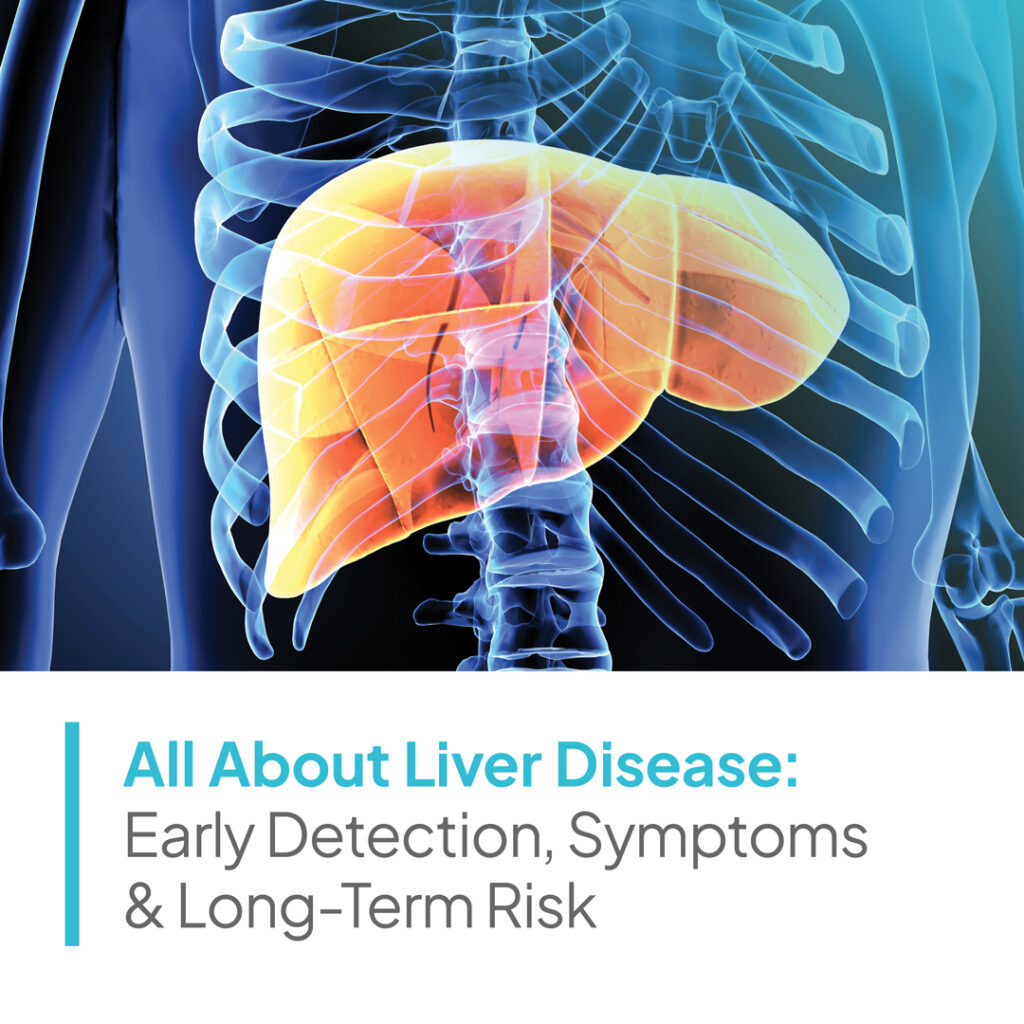Liver disease is a growing concern across the globe, especially in the United States, where the prevalence of conditions like Metabolic Dysfunction-Associated Steatotic Liver Disease (MASLD) and Metabolic Dysfunction-Associated Steatohepatitis (MASH) is on the rise. These diseases, which can progress to cirrhosis, liver cancer, and liver failure, often show no symptoms until it’s too late, making early detection and management crucial. This article delves into the significance of liver health, the role of FibroScan in liver disease detection, and the impact of MASLD and MASH (formerly called NAFLD and NASH), including the specific risks faced by the Latino community.
Understanding Liver Disease and Early Detection
What is Liver Disease?
Steatotic liver disease is a condition characterized by the accumulation of fat in the liver. In fact, it was once called fatty liver disease. This can happen if someone drinks too much alcohol (called MetALD) or sometimes has nothing to do with alcohol (called MASLD). MASLD includes different liver problems, one of the most serious being MASH (an abbreviation for “metabolic dysfunction-associated steatohepatitis”). MASH is a serious liver problem that can make the liver very sick, causing something called fibrosis, or even cirrhosis and liver cancer.
MASLD, MASH, MetALD, NASH Terminology and Recent Changes
Fatty liver disease has a new name and some new terms to understand. The old name, nonalcoholic fatty liver disease (NAFLD), is now called metabolic dysfunction-associated steatotic liver disease (MASLD). This change helps doctors talk about liver problems that aren’t caused by drinking alcohol. Within MASLD, there’s a serious condition that used to be known as nonalcoholic steatohepatitis (NASH), but it’s now called MASH (metabolic dysfunction-associated steatohepatitis). MASH is when the liver disease gets worse, leading to more severe liver damage like fibrosis (thickening or scarring of liver tissue), cirrhosis (severe scarring and poor liver function), and even liver cancer. This new terminology helps make sure everyone is clear about what kind of liver disease they’re talking about, especially when alcohol isn’t the cause.
Early Detection: What Is a FibroScan?
A liver health ultrasound (elastography or FibroScan®) is a non-invasive, quick, and painless procedure that utilizes ultrasound technology to assess liver health. It measures the speed of sound waves passing through the liver to identify scarring (fibrosis) and fat content. This tool is pivotal in the early detection of liver disease, allowing for timely intervention and management.
Who Can Benefit from a FibroScan?
FibroScan is beneficial for individuals at risk of liver disease, enabling proactive monitoring of liver changes and the effectiveness of treatment plans. It’s particularly useful for those with risk factors such as high blood pressure, high levels of triglycerides, type 2 diabetes, and obesity, which are associated with MASLD and MASH.
The Growing Concern with Liver Disease
Who does Liver Disease affect?
MASLD affects individuals who consume little to no alcohol and can progress to MASH, characterized by liver inflammation and potential advancement to cirrhosis and liver failure. The condition is linked to various factors, including high cholesterol, metabolic syndrome, obesity, and more. Lifestyle changes, such as regular exercise and a nutritious diet, can significantly impact the progression of liver disease.
Despite misconceptions, MASH is a severe condition that can affect anyone, not just those who abuse alcohol. There are no FDA-approved treatments, but lifestyle modifications and certain treatments can alter the disease course. Public awareness and accurate information are vital for early detection and management.
Increased Risk of Liver Disease in Latinos
The Latino community faces a higher risk of liver disease due to factors like obesity, metabolic syndrome, dietary habits, and genetics. Approximately half of all Hispanics and Latinos carry the PNPLA3 gene, significantly increasing their risk of liver disease.
Symptoms and Effects of Chronic Liver Disease
Chronic liver disease encompasses a spectrum of conditions that progressively damage the liver, impairing its ability to perform vital functions essential for life. Among these conditions, liver cirrhosis and its associated complications, such as ascites and hepatic encephalopathy (HE), stand out for their significant impact on patients’ health and quality of life.
What is Liver Cirrhosis?
Cirrhosis of the liver is the result of too much scarring (called fibrosis) in the liver. The scarring occurs because of liver diseases and conditions, including chronic alcohol use and hepatitis. The liver is able to repair itself when damaged, however, if the liver is constantly working to repair itself, permanent scar tissue will form over time. This tissue keeps the liver from working properly, causing blocks in blood flow and the liver’s ability to process. Being diagnosed with cirrhosis doesn’t imply immediate fatality. However, as the disease progresses, more scar tissue forms, causing decreased liver function. It also can cause other conditions, such as hepatic encephalopathy, which affects brain function due to the liver’s inability to remove toxins from the blood.
A Deeper Dive Into the Connection Between Liver Health and Hepatitis
Velocity Principal Investigator and Hepatologist, Dr. Nadege Gunn, answers questions to help prevent or address MASLD (Previously named Non-Alcoholic Fatty Liver Disease) in this interview with the American Liver Foundation↗.
What is Ascites?
Ascites is a medical term used to refer to the free abdominal fluid that can accumulate in the belly of cirrhotic individuals. This fluid buildup in the abdomen usually results from increased pressure across the blood vessels that travel across the diseased liver. It’s commonly recognized by a person’s tense and distended abdomen. It can accompany other symptoms, such as abdominal discomfort, pain, difficulty breathing, and fatigue.
Approximately 70% of liver cirrhosis patients end up developing ascites. It happens because of lowered production of albumin, a protein made by the liver that helps keep fluid from leaking out of your blood vessels into other tissues, and carries hormones, vitamins, and enzymes throughout your body. In cirrhosis, scarring and inflammation damage the cells required to produce albumin, leading to a buildup of free abdominal fluid. This free abdominal fluid, known as ascites, can be incredibly uncomfortable for patients with liver cirrhosis. Abdominal fluid can prove dangerous if left untreated, resulting in complications such as infection.
Early detection can be vital to improving the quality of life for those afflicted with ascites. If you or someone you know has cirrhosis and begins to exhibit abdominal distension and rapid weight gain, it’s important to get checked by a physician as soon as possible.
What is Hepatic Encephalopathy?
Your liver performs over 500 important functions for your body. One of its most important roles is to clean your blood. When the liver doesn’t work properly, toxins begin to build up in your bloodstream. Once they travel to the brain, these toxins cause trouble for your nervous system and brain function. The resulting disorder is called Hepatic Encephalopathy or HE.
HE often occurs in people who have a chronic liver disease such as cirrhosis. It can be mild or severe and, if treated, can be reversible. It has a wide array of symptoms that affect your brain, speech, nerves, personality, coordination, and more. Up to 70% of those with liver cirrhosis develop symptoms of HE, so prevention is important to avoid developing this disorder and the resulting damage.
Clinical Trials for MASH and Liver Health
Currently, there is no approved medication specifically for the treatment of MASH. The standard recommendations for managing steatotic liver disease and MASH involve lifestyle modifications. These include weight loss through a healthy diet and regular exercise, as well as the management of associated conditions such as diabetes, high blood pressure, and high cholesterol.
The field of MASH research has seen exciting developments in recent years. Several potential therapeutic targets and drug candidates are being explored to address the unmet medical need for effective MASH treatments.
Velocity Clinical Research is actively involved in conducting clinical trials for investigational medications aimed at treating MASH. These trials aim to evaluate the safety and effectiveness of potential medications for steatotic liver disease and MASH.
Participating in a clinical trial can provide individuals with access to cutting-edge therapies and contribute to the advancement of MASH research. If you’re interested in learning more about ongoing clinical trials for MASH and MASLD at Velocity, fill out this form and speak with a recruitment specialist.
The future of MASH treatment holds promise, and ongoing research endeavors are dedicated to finding effective therapies to combat this increasingly prevalent liver disease.

